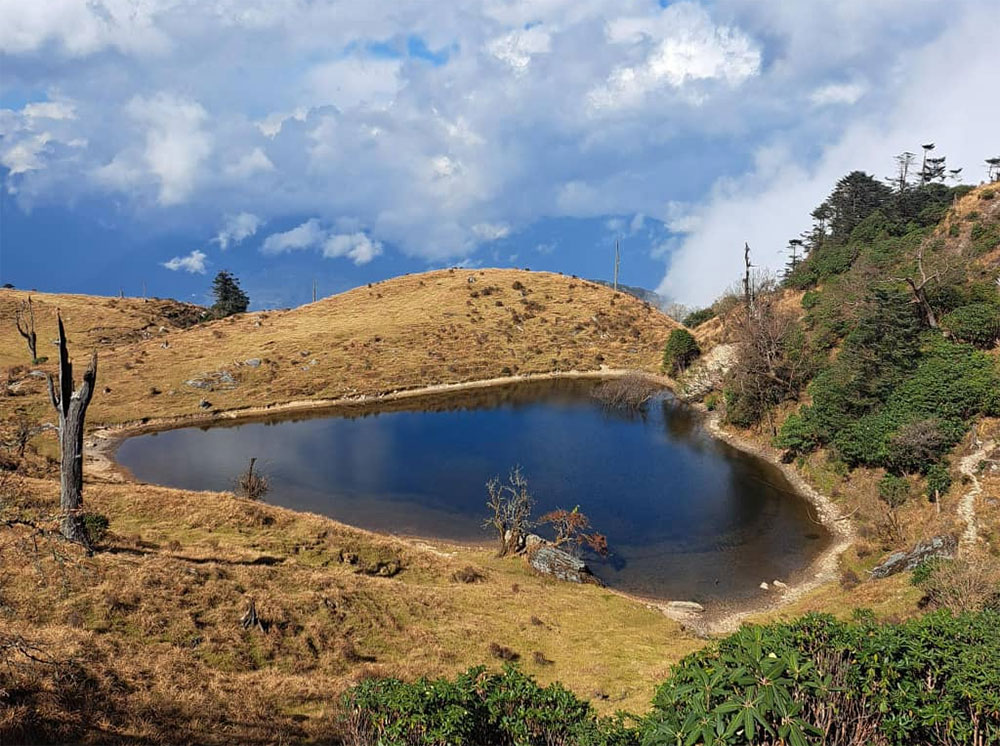Dechen Dolkar
The Dzongkhag Administration of Haa has established a fresh trekking path leading to Jo Bay Tsho, situated on the border between Gakaling and Sombaykha gewogs.
The two-day trek covers a distance of around 25 kilometres. It starts with an 84-kilometre drive from Sombaykha to Mochhu, a charming location surrounded by forward-thinking farming communities. Along the journey, trekkers can appreciate the captivating scenery of Bhutan’s countryside.
Haa Dzongdag Melam Zangpo said that the construction of the trail started in 2022. It took around three to four months to complete; it was completed in early 2023. The construction of the trail was awarded to two local contractors at two different sites.
Melam Zangpo said that though people might have trekked the route before, it had become inaccessible.
The journey to Jo Bay Tsho begins with a visit to a temple of profound cultural importance. This sacred site is home to 1,000 statues of Guru Rinpoche, laying the foundation for a spiritually enriching experience for trekkers embarking on this adventure.
As the trail ascends into the forested hills, dense clusters of bamboo flank the path, crafting a peaceful and inviting ambiance for the journey ahead.
After approximately six hours of trekking, adventurers arrive at a verdant pasture. Here is the campsite, situated just over a kilometre from the Jo Bay Tsho Trek. This campsite provides a comfortable base for visitors to delve into the scenic surroundings. It features a small camphouse with two rooms, capable of accommodating 8-10 people.
The next day, trekkers resume their journey, welcomed by the allure of smaller lakes concealed along the trail beneath the towering canopy of trees.
Throughout the trek, travellers are treated to a picturesque journey through forests, majestic mountains, and serene lakes, promising an experience that will imprint itself in the memory of every adventurer.
As travellers make their way along the gently sloping trail, they encounter lush green forests, dense clusters of bamboo, and the rich natural beauty of the surroundings. The path meanders through wooded areas, occasionally revealing expansive pastures and slightly challenging narrow passages. Along the way, glimpses of wild animals and peaceful lakes further enhance the serene ambiance.
Warm hospitality awaits visitors from the locals they encounter along the way, adding to the sense of community and camaraderie during the trek.
Finally, the journey culminates at Jo Bay Tsho, a stunning hidden lake stretching approximately 300 metres in length and 200 metres in breadth. It is a breathtaking finale to an unforgettable trekking experience.
The Jo Bay Tsho
“Bay Tsho” translates to “hidden lake.” It became the focal point of a dramatic incident involving Pangbe Lam Terton Sherab Mebar and his team, who embarked on a mission to extract gold from the lake’s golden post.
The story has it that, summoning all his powers, the Lam drew all the water into his mouth to facilitate the gold extraction, and his team began their work. However, realising that his team was exceeding the permissible limits of extraction, the Lam intervened. In a dramatic turn of events, the water escaped from his mouth, submerging his team members. To escape, the Lam transformed himself into a bat, while Jo Bay Tsho assumed the form of a bird to pursue him.
The chase eventually reached Tergola, where Jo Tergo, the local deity, intervened, prohibiting the Lam from venturing beyond Tergola. This incident fostered the belief that individuals from areas beyond Tergola were not permitted to marry individuals from Paro Pangbesa.
Even today, residents of Samtse and Sombbaykha continue to worship Jo Bay Tsho, seeking blessings in their daily lives.


